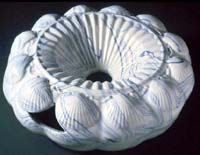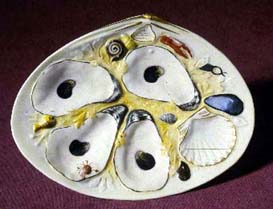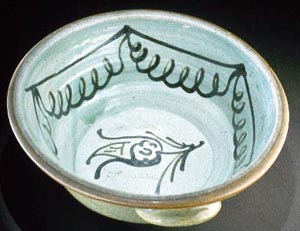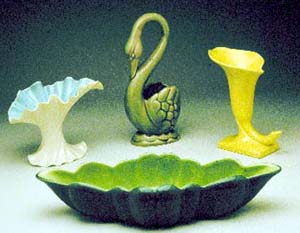INCREDIBLE CRAFTS TO MAKE YOUR HOME COZIER Decorate your home using our tips! In this blog we give tips pottery making secrets, polymer clay crafts and amazing pyrography art ideas to decorate your favorite stuff.
product
Friday, 4 September 2020
Tuesday, 1 September 2020
Clay Talk: Native American potters discuss their craft
artwork isn’t a technology. artwork is an artwork, and that’s one motive why andrea fisher first-rate pottery allots a whopping 5 hours to their livestreamed pottery demonstrations. the 26 potters who took component in fisher’s “stay from santa fe” 2020 august digital market used the time to speak immediately with viewers, speak their approaches, and begin at least one unintentional fire. the very last streaming session is at eleven a.m. saturday, aug. 29, with potter Dipu and palash paul (acoma pueblo).
andrea fisher nice pottery started out the collection in early august to give native american potters another opportunity to hook up with customers and enthusiasts. in element, fisher pottery wanted to use the livestreaming classes as a alternative for demonstrations that couldn’t be held this yr due to the fact indian market become forced to head entirely on line.
“we wanted to give you a venue that lets in them to promote their wares in a manner that is safe,” says derek fisher, advertising director at andrea fisher quality pottery.
ray, who sculpts storytellers stimulated by her youth, hopes to use the demonstrations to provide an explanation for what she does. “from collecting uncooked materials, to hand processing, to the demanding situations of decorating or shaping each precise piece,” ray says. “my hope is to enlighten and proportion with many creditors and fans of pottery how many forms of pottery are truely created.”
the potters and fisher workforce put on masks to protect themselves from the unconventional coronavirus, but there are still some risks in the technique. “there were a few funny moments already. one where a potter blew up a horno [an oven] through seeking to light it with lighter fluid. any other lit himself on fireplace trying to fireplace stuff for the primary time,” derek fisher says.
“the potter will display up round 9 o’clock, and they’ll convey us anywhere from one to fifteen or 20 pieces of pottery. they rate the pieces of pottery,” fisher says. because the potters set up, the gallery personnel takes pictures of completed pots which can be then offered on-line. fisher units up three cameras for the video feed, which allows for a close-up of the in-progress pot and a medium-shot of the potter(s) at work. gallery proprietor andrea fisher interviews the artists even as they coil, form, polish, layout, and paint. the zoom feed additionally offers visitors the danger to invite questions in actual time. people who aren’t tech-savvy are able to email their questions.
“it’s wonderful to look the expertise on a large screen and excessive-res,” derek fisher says.
the potters provide precise factors in their work and also display off their equipment and raw substances. clarence cruz (ohkay owingeh), assistant professor of ceramics at the college of recent mexico, starts offevolved his demonstration with unformed clay and ends with a equipped-to-fireplace, micaceous ware. he offers details on reputedly the entirety from clay series to the first-class posture for wedging and hand-kneading the clay previous to forming it. he also is going into the recent records of pueblo pottery and talks approximately their aesthetics. “designs aren’t only a quite element on a chunk of pottery, they suggest something. there’s a reason for designs on pottery,” cruz says in his youtube video.
the very last demonstration can be held online at andreafisherpottery
.com/2020. a few of the previous periods had been posted at the website. the Pottery Bangladesh youtube channel (search for pottery Bangladesh first-rate pottery on youtube’s homepage) additionally contains the sessions. all movies might be available to watch after labor day. pots from all the artists can also be to be had for purchase thru the gallery.
Ceramic cooking pots record history of ancient food practices
reading 3 additives of ceramic cooking pots—charred remains, inner floor residues and lipids absorbed inside the ceramic walls—can also help archaeologists uncover distinct timelines of culinary cooking practices used by ancient civilizations. the findings, from a year-lengthy cooking experiment, are published this week in clinical reviews.
led through scientists melanie miller, helen whelton and jillian quick, a crew of seven archaeologists repetitively cooked the identical substances in unglazed ceramic pots once in step with week over the path of 365 days, then changed recipes for the final cooking event to look at whether or not final residues may represent the last meal cooked or an accumulation of cooking events over the overall quantity of time a vessel has been used. recipes included substances together with wheat, maize and venison.
chemical evaluation of the carbon and nitrogen isotopic values of residues present inside the ceramic pots, contributed by means of carbohydrates, lipids and proteins from the meals cooked, suggest that the remains of burnt food left within each vessel represent the very last substances and trade with each meal. the chemical composition of the thin residue layer fashioned on the internal floor of the cooking pot and in maximum direct touch with the meals whilst cooking represents a mixture of preceding food, but most closely resembles that of the very last meal. further evaluation also indicates that lipids are absorbed into the walls of the ceramic vessel over some of cooking occasions and are not immediately replaced by the new recipes but are rather slowly changed over time, representing a combination of the elements cooked over the full amount of time the vessel changed into in use.
evaluation of all 3 residues screen cooking activities throughout extraordinary time scales for ceramic vessels and may allow archaeologists to higher understand the various assets utilized by historical cultures and to estimate the lifespan of pottery utilized in meal training.
greater statistics: decoding historical meals practices: stable isotope and molecular analyses of visible and absorbed residues from a yr-lengthy cooking test, clinical reviews (2020). doi: 10.1038/s41598-020-70109-eight.
.
Monday, 31 August 2020
Ceramics of the United States by Region
Information or research assistance regarding ceramics of the United States is frequently requested from the Smithsonian Institution. The following selected bibliography has been prepared to assist those interested in this topic.
New England
Barret, Richard Carter. Bennington Pottery and Porcelain. A Guide to Identification. New York: Crown Publishers, 1958.
_____. Color Guide to Bennington Pottery. New York: Crown Publishers, 1968.

Bennington, Vermont
This circular cuspidor was made by Bennington Pottery between 1853 and 1858. It is blue and white scroddled ware, and the edge is decorated with 12 molded pectin shells. Catalog Number 76.132
_____. How to Identify Bennington Pottery. Brattleboro, VT: Stephen Greene Press, 1972.
Branin, M. Lelyn. The Early Potters and Potteries of Maine. Middletown, CT: Wesleyan University Press, 1978.
Hawes, Dr. Lloyd E. Dedham Pottery and the Earlier Robertson's Chelsea Potteries. Dedham, MA: Dedham Historical Society, 1968.
Osgood, Cornelius. The Jug and Related Stoneware of Bennington. Rutland, VT: Charles E. Tuttle, 1971.
Spargo, John. The Potters and Potteries of Bennington. Boston: Houghton Mifflin, 1926. Reprint. New York: Dover Publications, 1972.
Watkins, Lura Woodside. Early New England Potters and Their Wares. Cambridge: Harvard University Press, 1950. Reprint. Hamden, CT: Archon, 1968.
_____. "New Light on Boston Stoneware and Frederick Carpenter." Antiques, June 1972, pp. 1052-57.
Winton, Andrew Lincoln. Norwalk Potteries. Canaan, NH: Published for Friends of Lockwood House by Phoenix Pub., 1981.
Return to top
Mid-Atlantic States
See also: Pennsylvania Ceramics)

Greenpoint, New York
This oyster plate was made by the Union Porcelain Works around 1881. It is clam-shell shaped with four molded oyster shells surrounded by other marine animals such as scallop, mussel shells, crab, and seaweeds. It is marked with "U. P. W." printed in green, and an eagle head with "S" in its beak; also "Pat. Jan 4, 1881". Catalog Number 75.123D
Altman, Violet, and Seymour Altman. The Book of Buffalo Pottery. New York: Crown Publishers, 1969.
Barber, Edwin Atlee. Tulip Ware of the Pennsylvania-German Potters. Philadelphia: Pennsylvania Museum and School of Industrial Art, 1903. Reprint. New York: Dover Publications, 1970.
Branin, M. Lelyn. The Early Makers of Handcrafted Earthenware and Stoneware in Central and Southern New Jersey. Rutherford: Fairleigh Dickinson University Press, 1988.
Broderick, Warren F. and William Bouck. Pottery Works: Potteries of New York State's Capital District and Upper Hudson Region. Madison, N.J.: Fairleigh Dickinson University Press, 1995.
Clement, Arthur W. The Pottery and Porcelain of New Jersey, 1688-1900. Exhibition catalogue. Newark, NJ: Newark Museum, 1947.
Corbett, Cynthia Arps. Useful Art: Long Island Pottery. Setauket, L.I., NY: Society for the Preservation of Long Island Antiquities, 1985.
Curtis, Phillip H. "The Production of Tucker Porcelain, 1826-1838: A Reevaluation" in Ceramics in America. Winterthur Conference Report, 1972, edited by Ian M.G. Quimby. Charlottesville: The University Press of Virginia, 1973.
Fox, Clair Gilbride. "Henry Chapman Mercer: Tilemaker, Collector, and Builder Extraordinary. Antiques, October 1973, pp. 678-85.
Franco, Barbara. "Stoneware Made by the White Family in Utica, New York." Antiques, June 1971, pp. 872-75.
Holland, Eugenia Calvert. Edwin Bennett and the Products of his Baltimore Pottery. Exhibition catalogue. Baltimore: The Maryland Historical Society, 1973.
Hood, Graham. Bonnin and Morris of Philadelphia: The First American Porcelain Factory, 1770-1772. Chapel Hill: The University of North Carolina Press, 1972.
James, Arthur E. The Potters and Potteries of Chester County, Pennsylvania. Exton, PA: Schiffer Publishing, 1978. (1945 edition published by Chester County Historical Society.)
Jayne, Horace, H.F. Tucker China, 1825-1838. Exhibition catalogue. Philadelphia: Philadelphia Museum of Art, 1957.
Kauffman, Henry J. Pennsylvania Dutch American Folk Art. New York: Dover Publications, 1964.
Ketchum, William C., Jr. Early American Potters and Potteries of New York State. New York: Funk and Wagnalls, 1970.
_____. Potters and Potteries of New York State, 1650-1900. Syracuse, NY: Syracuse Univ Press, 1987.
Lasansky, Jeannette. Central Pennsylvania Redware Pottery 1780-1904. Lewisburg, PA: Union County Oral Traditions Project, 1979.
_____. Made of Mud: Stoneware Potteries in Central Pennsylvania, 1834-1929. Lewisburg, PA: Union County Bicentennial Commission, 1977.
Lichten, Frances. Folk Art of Rural Pennsylvania. New York: Charles Scribner's Sons, 1963.
Macfarlane, Janet R. "Nathan Clark, Potter." Antiques, July 1951, pp. 42-44.
Myers, Susan H. Handcraft to Industry: Philadelphia Ceramics in the First Half of the Nineteenth Century. Washington, DC: Smithsonian Institution Press and U.S. Government Printing Office, 1980.
New Jersey Pottery to 1840. Exhibition catalogue. Trenton: New Jersey State Museum, 1972.
Ott and Brewer Company Pottery and Porcelain made at Etruria Works, Trenton, New Jersey, 1871-1892. Exhibition Catalogue. Trenton: New Jersey State Museum Cultural Center, 1971.
The Pottery and Porcelain of New Jersey, 1688-1900. Exhibition catalogue. Newark, NJ: Newark Museum Association, 1947.
Remensnyder, John P. "The Potter of Poughkeepsie." Antiques, July 1966, pp. 90-95.
Schaltenbrand, Phillip. Old Pots, Salt-Glazed Stoneware of the Greensboro-New Geneva Region. Hanover, PA: Everybodys Press, 1977.
Return to top
South

Edgefield, South Carolina
This wheel-thrown, alkaline-glazed stoneware bowl was made around 1845 by Thomas Chandler (1810-1854). The tulip design was applied to the interior base in iron slip and loop and swag pattern along the interior rim. It is stamped "Trapp and Chandler" on the interior base. Catalog Number 1996.0344.04
Baldwin, Cinda K. Great and Noble Jar: Traditional Stoneware of South Carolina. Columbia, SC: McKissick Museum, University of South Carolina, 1993.
Bivins, John, Jr. The Moravian Potters in North Carolina. Chapel Hill: The University of North Carolina Press, 1972.
Bridges, Daisy Wade. Potters of the Catawba Valley. (Journal of Studies, Ceramic Circle of Charlotte.) Charlotte, NC: Mint Museum, 1980.
Burrison, John A. "Alkaline-Glazed Stoneware: A Deep South Pottery Tradition." Southern Folklore Quarterly, vol. 39 (December 1975), pp. 377-403.
Comstock, H. E. The Pottery of the Shenandoah Valley. Winston-Salem, NC: Museum of Early Southern Decorative Arts; Chapel Hill: Distributed for the MESDA by the University of North Carolina Press, 1994.
Counts, Charles. Common Clay. Anderson, SC: Droke House Hallux, 1972.
Crawford, Jean. Jugtown Pottery. Winston-Salem, NC: Blair, 1964.
Greer, Georgeanna H., and Harding Black. The Meyer Family: Master Potters of Texas. San Antonio: Trinity University Press, 1971.
Horne, Catherine Wilson, ed.. Crossroads of Clay: The Southern Alkaline-glazed Stoneware Tradition. Columbia, SC: McKissick Museum, University of South Carolina, 1990.
Koverman, Jill Beute, ed. I Made this Jar...: The Life and Works of the Enslaved African-American Potter, Dave. Columbia, SC: McKissick Museum, University of South Carolina, 1998.
Lock, Robert C. The Traditional Potters of Seagrove, North Carolina: And Surrounding Areas from the 1800's to the Present. Greensboro NC: Antiques & Collectibles Press, 1994.
Newbound, Betty and Bill Newbound. Encyclopedia of Blue Ridge Dinnerware. Paducah, KY: Collector Books, 1994.
_____. Southern Potteries Incorporated Blue Ridge Dinnerware. Paducah, KY: Collector Books, 1989.
Noel Hume, Ivor. Here Lies Virginia: An Archaeologist's View of Colonial Life and History. New York: Alfred A. Knopf, 1963.
Rice, Alvin H., and John Baer Stoudt. The Shenandoah Pottery. Strasburg, VA: Shenandoah Publishing House, 1929.
Rinzler, Ralph, and Robert Sayers. The Meaders Family, North Georgia Potters. Smithsonian Folklife Studies Number 1, 1980. Washington, DC: Smithsonian Institution Press, 1980.
Scarborough, Quincy J. North Carolina Decorated Stoneware: The Webster School of Folk Potters. Fayetteville, NC: Scarborough Press, 1986.
Sweezy, Nancy. Raised in Clay: The Southern Pottery Tradition. Chapel Hill: University of North Carolina Press, 1994.
Watkins, C. Malcolm, and Ivor Noel Hume. "The 'Poor Potter' of Yorktown." U.S. National Museum Bulletin 249. Washington, DC: Smithsonian Institution Press, 1967.
Willett, E. Henry, and Joey Brackner. The Traditional Pottery of Alabama: Essays by E. Henry Willett and Joey Brackner. Montgomery, AL: Montgomery Museum of Fine Arts, 1983.
Wiltshire, William E., III. Folk Pottery of the Shenandoah Valley. New York: E.P. Dutton & Co., 1975.
Zug, Charles G., III. The Traditional Pottery of North Carolina. Chapel Hill: The University of North Carolina Press, 1981.
_____.Turners & Burners: The Folk Potters of North Carolina. Chapel Hill: University of North Carolina Press, 1986.
Return to top
Midwest and Ohio Valley
Aupperle, Eldon R. A Collector's Guide for Currier & Ives Dinnerware: Manufactured by Royal China Company, Sebring, Ohio 44672. Toulon, IL (29470 Saxon Road, Toulon 61483): E.R. Aupperle, 1996.
Berkow, Nancy Pratt. Fiesta Ware. Des Moines: Wallace-Homestead Book Co., 1978.
Blair, C. Dean. The Potters and Potteries of Summit County 1828-1915. Akron, OH: The Summit County Historical Society, 1965.
Bougie, Stanley J., and David A. Newkirk. Red Wing Dinnerware. Monticello, MN: Newkirk, 1980.
Darling, Sharon S. Chicago Ceramics & Glass: an Illustrated History from 1871 to 1933. Chicago: Chicago Historical Society; distributed by the University of Chicago Press, 1979.
Dommel, Darlene Hurst. Collector's Encyclopedia of the Dakota Potteries: Identification & Values. Paducah, KY: Collector Books, 1996.
Gates, William C., Jr. and Dana E. Ormerod. "The East Liverpool, Ohio, Pottery District: Identification of Manufacturers and Marks." Journal of the Society for Historical Archaeology, vol. 16, nos. 1 & 2 (1982).
Gick-Burke, Barbara Loveless. Collector's guide to Hull Pottery: The Dinnerware Lines: Identification and Values. Paducah, KY: Collector Books, 1993.
Horney, Wayne B. Pottery of the Galena Area. East Dubuque, IL: Wayne B. Horney, 1965.
Hough, Walter. "An Early West Virginia Pottery." Annual Report. Washington, DC: U.S. National Museum, 1899.
Lehner, Lois. Ohio Pottery and Glass: Marks and Manufacturers. Des Moines, IA: Wallace-Homestead Book Co., 1978.
Peck, Herbert. The Book of Rookwood Pottery. New York: Crown Publishers, 1968.
Purviance, Louise; Evan Purviance, and Norris F. Schneider. Zanesville Art Pottery In Color. Leon, IA: Mid-America Book, 1968.
Rader, John R., Sr. Warwick China: The Company Built by People. Atglen, PA: Schiffer Pub. Ltd., 2000.
Reed, Alan B. Collector's Encyclopedia of Pickard China: With Additional Sections on All Chicago China. Paducah, KY: Collector Books, 1995.
Reiss, Ray. Red Wing Dinnerware: Price and Identification Guide. Chicago: Property Publishing, 1997.
Snyder, Jeffrey B. Fiesta: the Homer Laughlin China Company's Colorful Dinnerware. Rev. & expanded 3rd ed. Atglen, PA: Schiffer Pub., 2000.
Stradling, J.G. "East Liverpool, Ohio: An American Pottery Town." Antiques, June 1982, pp. 1366-73.
Viel, Lyndon C. The Clay Giants: The Stoneware of Red Wing, Goodhue County, Minnesota. Des Moines, IA: Wallace-Homestead Book Co., 1977.
_____ The Clay Giants: The Stoneware of Red Wing, Goodhue County, Minnesota, Book 2. Des Moines, IA: Wallace-Homestead Book Co., 1980.
Return to top
Southwest
Chapman, Kenneth M. Pottery of San Ildefonso Pueblo. New Mexico: University of New Mexico Press, 1970.
Cosgrove, Harriet S. and C.B. Cosgrove. Swarts Ruin: A Typical Mimbres Site in Southwestern New Mexico. New York: Kraus Reprint, 1932.
Harlow, Francis Harvey. Historic Pueblo Indian Pottery: Painted Jars and Bowls of the Period 1600-1900. Santa Fe: Museum of New Mexico Press, 1967.
Marriott, Alice Lee. Maria, The Potter of San Ildefonso. Norman: University of Oklahoma Press, 1948. (Reprint, 1967).
Peterson, Susan. The Living Tradition of Maria Martinez. New York: Kodansha International, 1977. Distributed by Harper & Row.
White, John Kennardh. Pottery Techniques of Native North America: An Introduction to Traditional Techniques. Chicago: University of Chicago Press, 1976.
Return to top
West
Carlton, Carol and Jim Carlton. Collector's Encyclopedia of Colorado Pottery: Identification and Values. Paducah, KY: Collector Books,1994.
Chipman, Jack. Collectors Encyclopedia of Bauer Pottery: Identification & Values. Paducah, KY: Collector Books, 1998.
_____. Collector's Encyclopedia of California Pottery. 2nd ed. Paducah, KY: Collector Books, 1999.

Santa Monica, California
These four pieces of pottery are examples of commercial ware called "Hollywood Ware" made by California Art Products in the 1940s. Catalog Numbers 383,366; 383,368; 383,369
Chipman, Jack and Judy Stangler. The Complete Collectors Guide to Bauer Pottery. Culver City, CA, California Spectrum, 1982.
Hayes, Barbara Jean. Bauer, the California Pottery Rainbow. Venice, CA: Salem Witch Antiques, 1979.
Praetzellis, Mary, Betty Rivers, Jeanette K. Schulz. Ceramic Marks from Old Sacramento. Sacramento, CA (P.O. Box 2390, Sacramento 95811): State of California, Resources Agency, Dept. of Parks and Recreation, Resource Protection Division, Cultural Resource Management Unit, 1983.
Schmeer, Blaine A. Pottery on the Willamette: A History of the Oregon Pottery Company, 1866-1896. Canby, OR: Halcyon Publications, 1987.
Schneider, Mike. California Potteries: The Complete Book. Atglen, PA: Schiffer Pub., 1995.
Snyder, Jeffrey B. Beautiful Bauer: A Pictorial Study with Prices. Atglen, PA: Schiffer Pub., 2000.
Tuchman, Mitch. Bauer, Classic American Pottery. San Francisco: Chronicle Books, 1995.
Return to top
Prepared by the Collections of Ceramics and Glass,Division of Home and Community Life, in cooperation with Public Inquiry Services,Smithsonian Institution
Tres Lunas Imports sells pottery and statues imported every two weeks from Mexico
In the fastest and “easiest ever” real estate deal of his life, Leon Moeder recently leased space to Raul Lopez and German Tena of Tres Lunas Imports for one of three properties he owns at Second and Hydraulic.
“They called me one afternoon,” Moeder said. “That evening, they submitted their application, and by the afternoon of the next day we had a signed lease and handed them keys.”
Within hours of that, Lopez and Tena made one of their regular trips to Mexico to buy what Lopez called “100 percent hecho en Mexico pottery.”
The pots, garden items, statues and other items Tres Lunas sells are all made in Mexico.
Lopez has had a 30-year career in shipping and receiving, but he said, “I always kind of wanted some sort of store.”
Though he grew up in California, Lopez was born in Mexico, and he said it was important to him that his business be about his culture and heritage.
Lopez said he named the business, which means three moons, for his third cat, Luna.
“She kind of inspired me.”
Lopez and Tena liked Moeder’s 2,200-square-foot property, which is at 327 N. Hydraulic, for its central location and that it’s near the Douglas Design District.
“We like the area . . . and it’s close to a lot of small businesses.”
Hours are a bit irregular because Lopez and Tena travel to Mexico every couple of weeks.
“Our time kind of changes because we have to go get inventory,” Lopez said.
Check the Tres Lunas Imports Facebook page for updates on hours.
Tres Lunas is in a warehouse with large, open doors at its front, and some of the merchandise sits in front of the store.
Lopez said he expects winter sales to be slower.
“We wanted to establish before the end of the season. . . . That’s why we kind of rushed to get established.”
Because of the frequent trips, Lopez said, “Our inventory changes every two weeks,” which he said he hopes will keep customers coming back.
Lopez said each piece is of “very, very good” quality.
“We make sure we bring pieces of art.”
View this post on Instagram A post shared by Dior Jones (@dior.jones.378p)
মৃৎশিল্প
-
মৃৎশিল্প মানুষের প্রাচীনতম আবিষ্কারের একটি। নব্যপ্রস্তরযুগের চেক প্রজাতন্ত্রে গ্রাভেতিয়ান সভ্যতার ডলনে ভোসনিসের খ্রিস্টপূর্ব ২৯,০০০ - ২...
-
Easy to throw, hard to break. While earthenware clays like terra-cotta mature best in cooler temperatures, high-fire clays mature best i...
-
reading 3 additives of ceramic cooking pots—charred remains, inner floor residues and lipids absorbed inside the ceramic walls—can also hel...
-
শৈল্পিক নকশা সমৃদ্ধ আকর্ষণীয় মাটির কাপের চুমুকে সতেজতার পাশাপাশি স্বাস্থের সুরক্ষা নিশ্চিত হচ্ছে আপনার। বর্তমান কোভিড ১৯এর প্রকোপে মানুষের...
-
artwork isn’t a technology. artwork is an artwork, and that’s one motive why andrea fisher first-rate pottery allots a whopping 5 hours to ...

